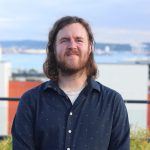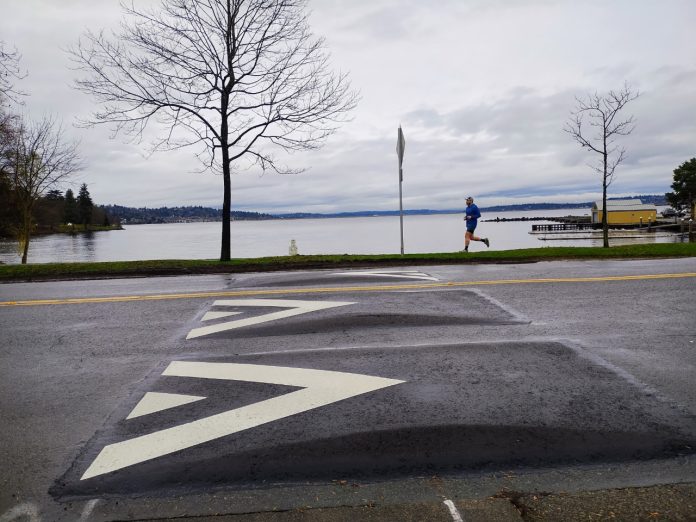
Seattle Parks and Recreation has officially hit the brakes on a plan to install speed cushions along a stretch of Lake Washington Boulevard through Southeast Seattle that is notorious for speeding motorists. The traffic calming infrastructure was set to be installed earlier this year, but after months of radio silence, City staff made an announcement this week quietly dropping the most substantive changes.
The move comes after a group opposed to many of the upgrades, Coexist Lake Washington, met directly with staff in Mayor Bruce Harrell’s office last year.
Only members of the public who had been following closely would have noticed that the new list of improvements planned for 2025 no longer includes six different sets speed bumps intended to keep driver speeds down. Nor does it include a planned intersection redesign intended to improve safety at S Orcas Street and Lake Washington Boulevard, a change that Coexist Lake Washington asserted has “no evident benefits” in an email to the City dated last May.
As Tom Fucoloro of the Seattle Bike Blog put it, “It’s not a good sign when I have to use the Wayback Machine to figure out what has been cut from a public project because the project team seems to be trying to hide it.” Fuculoro provided a full breakdown of which elements were thrown out in a story earlier this week.
Oddly the map of proposed changes does still include all of the original speed cushions, illustrating the fact that removing half of them really reduces the project’s scope and by extension its projected impact.
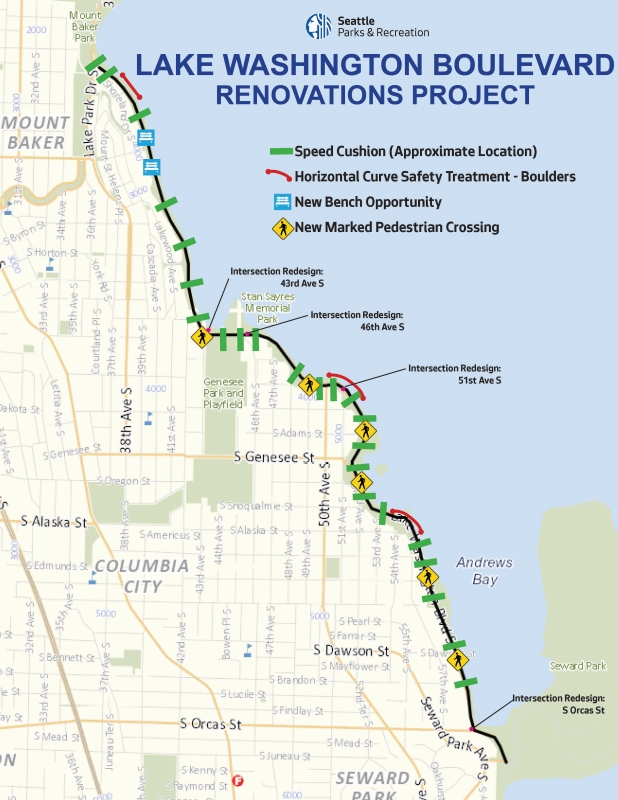
The project website does now allude to amorphous “future phases” of Lake Washington Boulevard upgrades, without specifics. The changes on deck were fully funded, and vetted by the Seattle Department of Transportation (SDOT). Parks is leading the work due to the fact that Lake Washington Boulevard sits on Parks property.
A Parks spokesperson was not able to provide a statement to The Urbanist as to why the speed cushions had been removed from the project, suggesting one will be available sometime next week.
Speed cushions had been moving forward on Lake Washington Boulevard as compromise treatment that everyone seemed to agree on, after a long process looking at other potential changes to the street in 2022 and 2023. And they had been explicitly supported by Coexist Lake Washington as an alternative for more intensive traffic calming like intersection narrowing. But in a new report buried on the project’s website, the Parks department describes the reaction to speed cushions as “polarizing.”
“Supporters credited [speed cushions] with significantly reducing speeding and making the corridor safer for walking and biking. Some called for more cushions, particularly on the southern segments of the corridor to address persistent speeding issues,” the report states. “However, opponents criticized the speed cushions for causing discomfort and raising the risk of vehicle damage. They also expressed concerns about safety hazards for motorcycles and vans equipped for mobility access. Some noted that the cushions prompted dangerous driving behavior as people attempted to avoid them.”
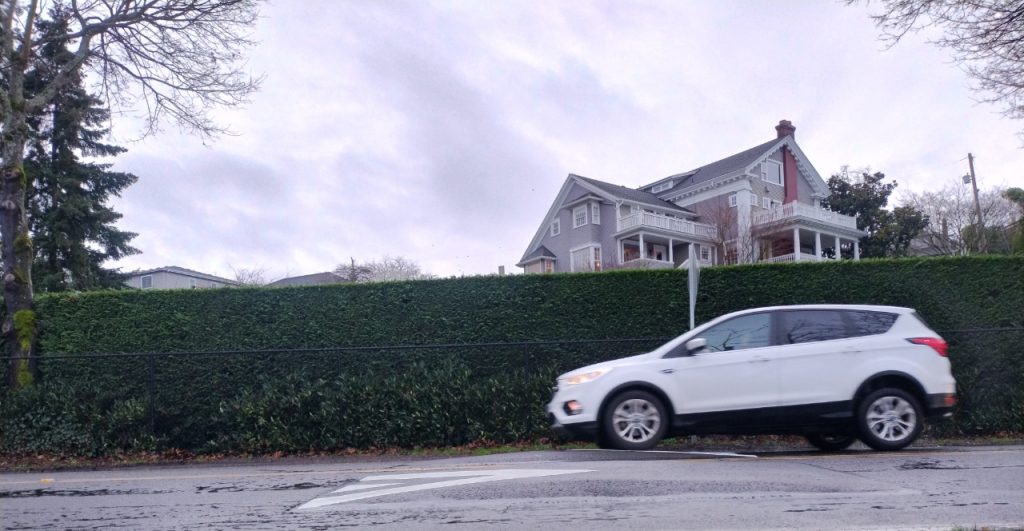
Speed cushions are a standard traffic calming treatment, and the city has been ramping up their installation in recent years, including in locations where it may not have been seen as feasible a decade ago, including on major bus routes.
An inescapable fact in the debate is that Lake Washington Boulevard is located in Mayor Bruce Harrell’s own neighborhood, and potential changes to the street have long received special treatment from the Mayor’s Office. The original funding for upgrades to the street, provided via a 2022 budget amendment from former Councilmember Tammy Morales — Harrell’s successor in representing District 2 on the council — was for a “protected path on parks property.” However, the Harrell Administration ultimately steered things in its own direction, and now looks to be stepping away halfway through.
The proposed changes at S Orcas Street, modifying a tricky three-way intersection to convert two legs to one-way operation, specifically came out of conversations with members of the public who use Lake Washington Boulevard.
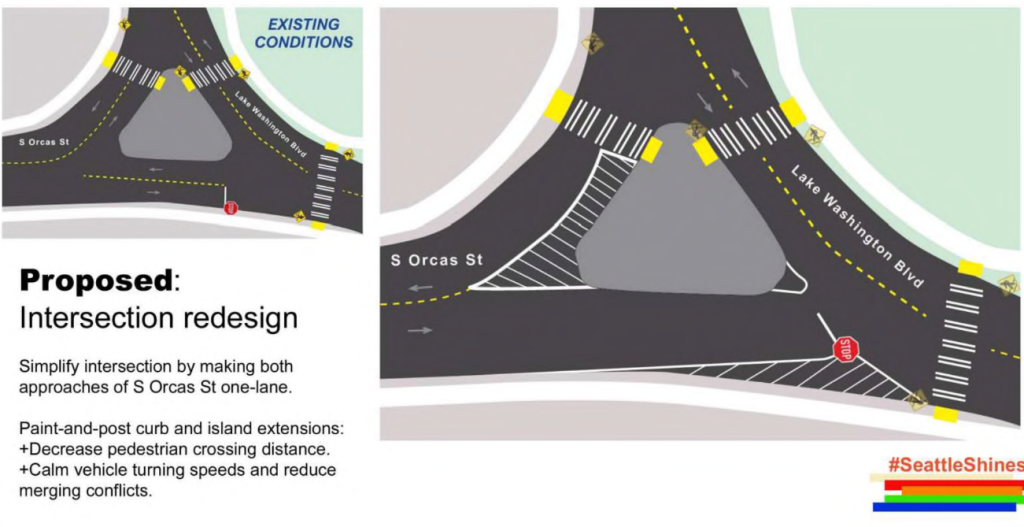
“During outreach, community suggested simplifying the intersection or remove the slip lane altogether because the slip lane is causing near-misses between vehicles,” a 2024 SDOT Complete Streets review noted. “This design proposal would remove the potential conflict from vehicles that are westbound on S Orcas S and those making the southbound to westbound movement from Lake Washington Blvd to S Orcas St using the slip lane.”
In other words, the primary purpose of the change was to make the intersection safer for drivers. But now it will remain as-is for the foreseeable future.
The Urbanist reached out to the four candidates vying to be District 2’s next councilmember for their reaction to the city’s pull back.
“It’s deeply upsetting to hear that promised safety improvements are now being taken off the table. There have been numerous serious accidents on Lake Washington Boulevard, and there is NO QUESTION that they will continue unless and until further traffic calming improvements are made!” Eddie Lin, a lawyer in the Seattle City Attorney’s office, told The Urbanist. “Too many drivers use Lake Washington Boulevard like a speedway, endangering the lives of pedestrians and bicyclists, including elders, families and children. This is unacceptable and we cannot wait for yet another injury to occur to complete these previously agreed-upon safety improvements.”
“We have a traffic safety crisis in South Seattle. I oppose the Parks Department’s decision to eliminate common sense safety improvements like speed cushions and stop signs at critical intersections in their Lake Washington Boulevard Renovations Project,” union leader and Seattle Department of Construction and Inspections (SDCI) employee Jamie Fackler said. “The community overwhelmingly asked for changes to reduce speeding and turning / merging car crashes to keep all visitors to this park safe.”
But Adonis Ducksworth, who works in Mayor Harrell’s office as a transportation advisor, provided a statement that contrasted with his two opponents, suggesting that improvements to Lake Washington Boulevard might not be the best use of city dollars.
“To be clear, this is a Seattle Parks project and SDOT is implementing Park’s plan for Lake Washington Blvd. With that said, there are many dangerous streets in South Seattle,” Ducksworth said. “I am running on a platform of calming traffic on these streets, and providing needed expertise to protect pedestrians, bikers, and other vulnerable users from harm on the roads. Given my current role, this particular issue is a challenge for me — I see the value in making these changes, and also understand the need to prioritize as a citywide department. As the District 2 Councilmember, I’ll have the ability — and bully pulpit — to advocate for projects in my communities, and will certainly want to revisit these types of traffic interventions along with making strides to complete the bike network in South Seattle.”
Restaurant industry advocate Jeanie Chunn did not respond to a request for comment.
This reversal is probably the Harrell Administration’s highest-profile backpedal on a traffic safety project to date, after three years of advancing projects that had been started in previous administrations and shying away from micromanaging. Harrell faces a substantive challenge in his upcoming election from Transit Riders Union General Secretary Katie Wilson, who has championed transit and mobility issues on the campaign trail. But ensuring that drivers aren’t slowed down on Lake Washington Boulevard appears to be worth the political risk to Harrell that comes from abandoning the project.
Ryan Packer has been writing for The Urbanist since 2015, and currently reports full-time as Contributing Editor. Their beats are transportation, land use, public space, traffic safety, and obscure community meetings. Packer has also reported for other regional outlets including BikePortland, Seattle Met, and PubliCola. They live in the Capitol Hill neighborhood of Seattle.

